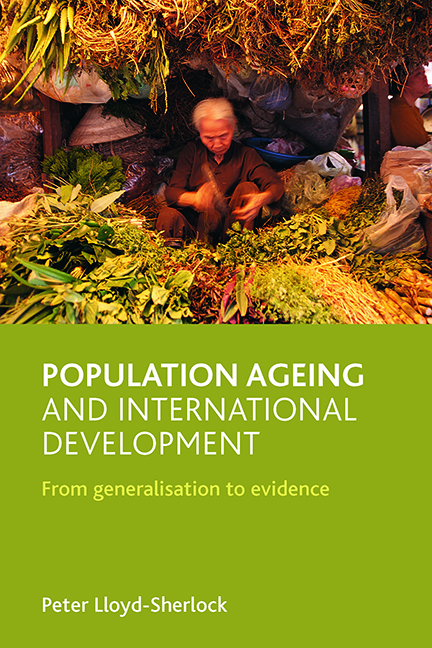Book contents
- Frontmatter
- Contents
- List of abbreviations
- Acknowledgements
- Notes on the author
- Introduction
- one International development and population ageing
- two Experiencing later life in contexts of development
- three Older people, pensions and development
- four Population ageing and health
- five Later life and social relations: family, migration and care
- six Ageing and development in South Africa
- seven Ageing and development in Argentina
- eight Ageing and development in India
- nine Conclusions and overview
- References
eight - Ageing and development in India
Published online by Cambridge University Press: 15 July 2022
- Frontmatter
- Contents
- List of abbreviations
- Acknowledgements
- Notes on the author
- Introduction
- one International development and population ageing
- two Experiencing later life in contexts of development
- three Older people, pensions and development
- four Population ageing and health
- five Later life and social relations: family, migration and care
- six Ageing and development in South Africa
- seven Ageing and development in Argentina
- eight Ageing and development in India
- nine Conclusions and overview
- References
Summary
Introduction
The selection of India for a case study can be justified purely in terms of its large population, which reached one billion in 2000. Although population ageing in India is less advanced than in countries such as Argentina (7% of Indians were aged 60 or more in 2005), the country's sheer size means that nearly an eighth of the world's population aged 60 and over live there. As well as scale, India presents deep-seated and complex patterns of diversity. These can be seen in terms of large development disparities between rural and urban districts and between the different states. They are also evident in strong traditional divisions based on religion, gender and caste, as well as increasing socioeconomic differentiation.
In addition, India offers a valuable case study of both continuity and change. India was granted independence from British rule in 1947, which means that current cohorts of older people have spent most or all of their lives in an independent country. Between the 1950s and the 1980s, economic performance was relatively sluggish, and many early aspirations failed to materialise. By contrast, in recent years India has experienced a dramatic surge in economic growth, based on manufacturing, as well as a dynamic new information technology and services sector. Yet the extent to which this boom is transforming the lives of its population, particularly older people, is questionable. The great majority of older people in India continue to live in rural areas, often in impoverished villages that have seen little economic or social progress during their lifetimes. These experiences contrast abruptly with the dramatic growth in prosperity of a small, new class of young, urban employees. As such, a key issue is why the socioeconomic status of so many Indians changed so little through the 20th century. This is highly relevant for the situation of current and future cohorts of older people. For example, it is estimated that less than 10% of the labour force are presently employed in formal sector activities, greatly reducing the scope for pension coverage (Harriss-White, 2003).
This chapter follows the same broad structure as the other country chapters. It begins with an overview of India's development since independence, before moving on to examine demographic trends and patterns of population ageing.
- Type
- Chapter
- Information
- Population Ageing and International DevelopmentFrom Generalisation to Evidence, pp. 201 - 230Publisher: Bristol University PressPrint publication year: 2010



